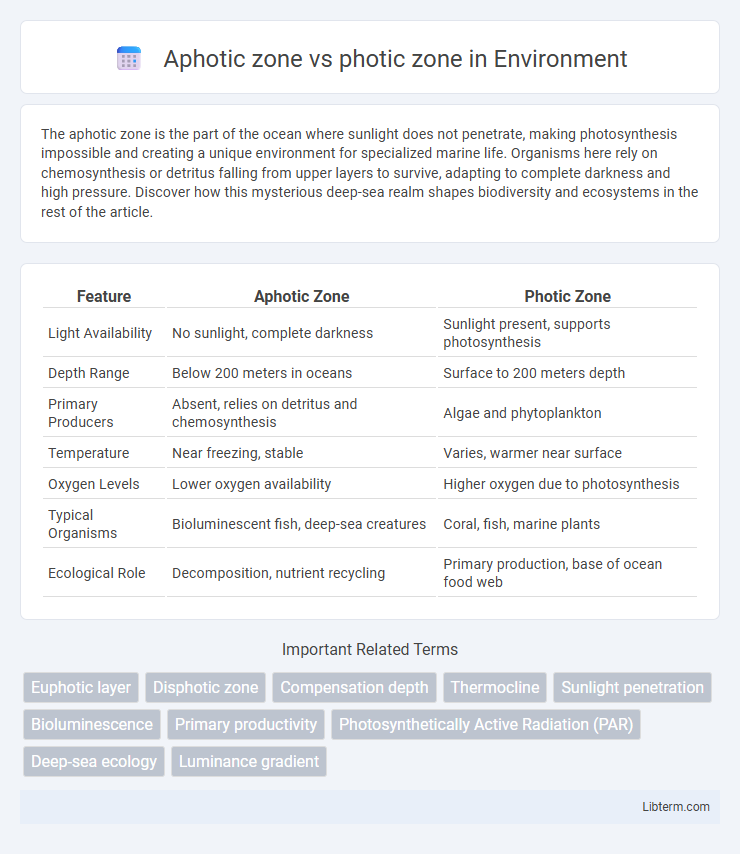The aphotic zone is the part of the ocean where sunlight does not penetrate, making photosynthesis impossible and creating a unique environment for specialized marine life. Organisms here rely on chemosynthesis or detritus falling from upper layers to survive, adapting to complete darkness and high pressure. Discover how this mysterious deep-sea realm shapes biodiversity and ecosystems in the rest of the article.
Table of Comparison
| Feature | Aphotic Zone | Photic Zone |
|---|---|---|
| Light Availability | No sunlight, complete darkness | Sunlight present, supports photosynthesis |
| Depth Range | Below 200 meters in oceans | Surface to 200 meters depth |
| Primary Producers | Absent, relies on detritus and chemosynthesis | Algae and phytoplankton |
| Temperature | Near freezing, stable | Varies, warmer near surface |
| Oxygen Levels | Lower oxygen availability | Higher oxygen due to photosynthesis |
| Typical Organisms | Bioluminescent fish, deep-sea creatures | Coral, fish, marine plants |
| Ecological Role | Decomposition, nutrient recycling | Primary production, base of ocean food web |
Overview of the Aphotic and Photic Zones
The photic zone, extending from the ocean surface to about 200 meters deep, receives sufficient sunlight to support photosynthesis, fostering diverse marine life such as phytoplankton and coral reefs. In contrast, the aphotic zone lies beneath the photic zone, where sunlight penetration is minimal or nonexistent, resulting in a dark environment that supports organisms adapted to low light conditions, like bioluminescent fish and deep-sea creatures. These zones create distinct ecological layers, with the photic zone driving primary production and the aphotic zone relying on organic matter falling from above or chemosynthesis for energy.
Definition of the Photic Zone
The photic zone is the upper layer of a body of water that receives enough sunlight to support photosynthesis, typically extending to depths of about 200 meters in clear ocean water. This zone is crucial for the growth of phytoplankton, which form the base of the marine food web. In contrast, the aphotic zone lies beneath the photic zone and lacks sufficient light for photosynthesis, leading to different ecological conditions.
Definition of the Aphotic Zone
The aphotic zone refers to the oceanic layer where sunlight fails to penetrate, typically beginning at depths of around 200 meters and extending to the ocean floor, resulting in complete darkness. Unlike the photic zone, which supports photosynthesis due to sufficient light, the aphotic zone relies on alternative energy sources, such as organic matter descending from above. This zone hosts specialized organisms adapted to survive without sunlight, often exhibiting bioluminescence and unique feeding strategies.
Depth Range Comparison
The photic zone extends from the ocean surface down to approximately 200 meters, where sunlight penetrates sufficiently for photosynthesis to occur. In contrast, the aphotic zone begins below this depth, typically starting around 200 meters and extending to the ocean floor, encompassing depths with no sunlight penetration. This depth range difference critically limits biological activity in the aphotic zone to organisms adapted to darkness and reliance on organic matter descending from the photic zone.
Light Availability and Its Effects
The photic zone receives sufficient sunlight to support photosynthesis, fostering diverse marine ecosystems with abundant algae and phytoplankton. In contrast, the aphotic zone lies below light penetration limits, resulting in complete darkness that inhibits photosynthetic life and favors organisms adapted to low light or bioluminescence. Light availability directly influences biological productivity and species distribution, making the photic zone rich in primary production while the aphotic zone depends on organic matter descending from above.
Temperature Variations Between Zones
The aphotic zone experiences consistently lower temperatures, often near freezing, due to the absence of sunlight penetration and limited heat absorption. In contrast, the photic zone showcases significant temperature fluctuations influenced by solar radiation, with surface waters warming considerably during daylight hours. These temperature variations affect marine life distribution, metabolic rates, and biochemical processes within each zone.
Biodiversity in Aphotic vs Photic Zones
The photic zone supports high biodiversity due to abundant sunlight enabling photosynthesis, which sustains a wide range of marine plants, plankton, and animals. The aphotic zone, lacking light, hosts specialized organisms adapted to dark, high-pressure environments, resulting in lower but unique and diverse biodiversity with species reliant on chemosynthesis or detritus from upper layers. Biodiversity in the photic zone is characterized by greater species richness, while the aphotic zone contains fewer, highly adapted species often exhibiting bioluminescence and other specialized traits.
Adaptations of Organisms in Each Zone
Organisms in the photic zone have adaptations such as chlorophyll for photosynthesis and vibrant coloration for mating and camouflage, relying on ample sunlight. In contrast, species in the aphotic zone exhibit bioluminescence for communication and predation, enhanced sensory organs for navigation in darkness, and slow metabolisms to conserve energy. These adaptations enable survival in environments characterized by either abundant light or complete darkness.
Ecological Importance and Functions
The photic zone supports primary productivity through photosynthesis by phytoplankton, forming the base of marine food webs and facilitating oxygen production. In contrast, the aphotic zone relies on organic matter descending from the photic zone, sustaining detritivores and deep-sea organisms critical for nutrient recycling and carbon sequestration. Both zones are essential for maintaining oceanic ecosystem balance, biodiversity, and global biogeochemical cycles.
Human Impact and Conservation Concerns
Human impact on the photic zone is significant due to pollutants, overfishing, and climate change, threatening biodiversity and disrupting marine ecosystems dependent on sunlight for photosynthesis. The aphotic zone faces indirect effects such as deep-sea mining and plastic pollution, which jeopardize fragile habitats and slow-recovering species adapted to darkness and high pressure. Conservation efforts prioritize reducing nutrient runoff, protecting core habitats, and regulating deep-sea activities to preserve both zones' ecological integrity and support global marine health.
Aphotic zone Infographic

 libterm.com
libterm.com